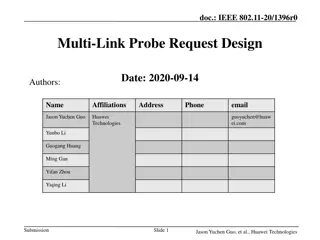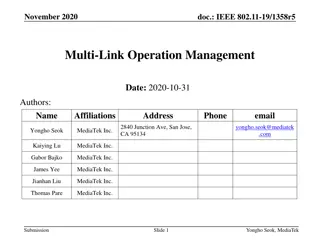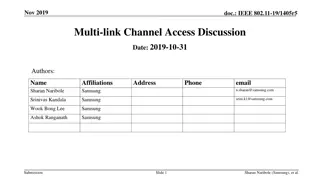Improving Multi-Link Power Management Efficiency in IEEE 802.11 Networks
The document discusses challenges with per-link power mode changes in multi-link scenarios in IEEE 802.11 networks, proposing a solution for more efficient power management. It addresses issues such as latency and inefficiencies in signaling for power mode changes, introducing scheduled multi-link p
6 views • 9 slides
Progress on IEEE 802.11 Multi-link Setup
Significant developments have been made in the multi-link setup within the IEEE 802.11 framework. The focus is on allowing only one STA in the MLD framework, differentiation with STA-level associations, and the rationale behind restricting to one STA. Proposals for defining multi-link devices and re
0 views • 12 slides
Design Considerations for Multi-Link Probe Requests in IEEE 802.11-20
This document discusses the design considerations for multi-link probe requests in the IEEE 802.11-20 standard. It covers passive and active scanning methods, MLD-based versus link-based approaches, and probing for multiple BSSIDs. The focus is on enhancing efficiency and reducing frame bloating in
0 views • 16 slides
IEEE 802.11-20/0772r2 Multi-Link Elements Overview
IEEE 802.11-20/0772r2 discusses various aspects of multi-link elements in the context of IEEE 802.11 standards. The document covers the need for efficient element ID extension, different multi-link element structures, including authentication algorithms, common controls, and sub-elements organizatio
1 views • 10 slides
IEEE 802.11-20/0055r0 Multi-link Block Ack Architecture Overview
This document from January 2020 presents an overview of the IEEE 802.11-20/0055r0 Multi-link Block Ack architecture proposed by Rojan Chitrakar from Panasonic. It discusses the negotiation of block ack agreements between multiple MLDs, common sequence number assignment, transmit and receive buffers,
1 views • 11 slides
Understanding Multi-AP Operation in IEEE 802.11-20-0617/r3
Explore the basic definitions and key features of Multi-AP operation in the IEEE 802.11 standard. Learn about Multi-AP Candidate Set (M-AP-CS) and Multi-AP Operation Set (M-AP-OS) along with their participants and formation. Delve into the concepts of Coordinator AP, Coordinated AP(s), and reliable
0 views • 19 slides
IEEE 802.11-2020 Multi-Link Reference Model Discussion
This contribution discusses the reference model to support multi-link operation in IEEE 802.11be and proposes architecture reference models to support multi-link devices. It covers aspects such as baseline architecture reference models, logical entities in different layers, Multi-Link Device (MLD) f
1 views • 19 slides
Understanding Different Types of Operating Systems
An operating system is the crucial program that manages a computer's resources and acts as an interface between the user and the machine. Various types of operating systems exist, including real-time, multi-user vs. single-user, multi-tasking vs. single-tasking, distributed, and embedded systems. Re
1 views • 11 slides
IEEE 802.11-23/1980r1 Coordinated AP-assisted Medium Synchronization Recovery
This document from December 2023 discusses medium synchronization recovery leveraging multi-AP coordination for multi-link devices. It covers features such as Multi-link device (MLD), Multi-link operation (MLO), and Ultra High Reliability (UHR) capability defined in P802.11bn for improvements in rat
0 views • 8 slides
Understanding Multi-Band Multi-Channel Concept in IEEE 802.11be
Exploring the benefits of Multi-Band Multi-Channel (MBMC) operation in IEEE 802.11be, this study delves into the efficient use of spectrum, increased data rates, and network load balancing. It also discusses the envisioned usage models and compares Single Band Operation with Multi-Band Operation, hi
2 views • 20 slides
Understanding Multi-Band, Multi-Channel Concept in IEEE 802.11be
Explore the advantages of Multi-Band, Multi-Channel (MBMC) operation in IEEE 802.11be, focusing on efficient spectrum use, increased data rates, and dynamic band switching. Learn about usage models and compare with single-band operations. Discover how MBMC enables concurrent operation across multipl
0 views • 22 slides
IEEE 802.11-19/1550r0: Simultaneous Tx/Rx Capability Indication for Multi-Link Operation
This document discusses the simultaneous Tx/Rx capability indication for multi-link operation in IEEE 802.11-19/1550r0. It covers scenarios where link selection depends on link capabilities, actions needed based on Tx/Rx capabilities, and methods to indicate simultaneous operation. The importance of
4 views • 10 slides
Enhancing IEEE 802.11 with Multi-Link Acknowledgment Mechanism
This document explores the concept of multi-link transmission in IEEE 802.11 networks as a means to enhance peak throughput. It delves into the proposal of a multi-link block acknowledgment mechanism for more efficient data transmission. The discussion includes details on existing block acknowledgme
0 views • 16 slides
IEEE 802.11-20/0370r0 Multi-link Power Save Discussion
The document discusses multi-link power saving in the IEEE 802.11be standard. It reviews extreme low power multi-link operation modes, emphasizing the importance of enabling a single link for practical power savings. The proposed extreme low power mode introduces fixed and dynamic anchor links for e
0 views • 11 slides
IEEE 802.11-19/1358r5 Multi-Link Operation Management Overview
This document provides insights into the multi-link operation management proposed for IEEE 802.11-19/1358r5 standard by MediaTek Inc. The concept involves handling multi-link entities, such as APs and STAs, for improved performance in different environments. It discusses the architecture, motivation
0 views • 15 slides
IEEE 802.11-20/0136r2: Virtual Carrier Sense in Multi-Link Networks
In this document presented in February 2020, the focus is on the implementation of virtual carrier sense (CS) in the context of multiple links in IEEE 802.11-20/0136r2. The advantages of NAC in asynchronous multi-link scenarios are discussed, emphasizing the mitigation of the hidden node problem and
0 views • 16 slides
Virtual Carrier Sense in Asynchronous Multi-Link Networks
Exploring the implementation of virtual carrier sense in asynchronous multi-link networks based on IEEE 802.11 standards. The presentation discusses the benefits of using NAV (Network Allocation Vector) in asynchronous multi-link setups to avoid hidden node issues, improve throughput, and latency. I
0 views • 16 slides
Virtual Carrier Sense in Multi-Link Networks
This document discusses the implementation and advantages of virtual carrier sense in multi-link networks under the IEEE 802.11 standard. It explores the operation of multi-link setups, asynchronous communication benefits, and the necessity of multiple contention channels. The concept of NAV (Networ
2 views • 11 slides
Accuracy of Multi-Month Refills of Antiretroviral Drugs in Malawi
Understanding the implementation of multi-month refills for stable patients in Malawi provides valuable insights into patient eligibility differentiation, with 86% eligible for multi-month scripts. Challenges remain in accurately applying eligibility criteria, as seen in the study's findings. The re
0 views • 13 slides
Enhancing Efficiency and Latency Reduction in IEEE 802.11be Through Multi-Link Operation
Targeted at improving multi-link and low-latency capabilities in IEEE 802.11be, this document proposes a mode of operation utilizing multiple links to decrease latency effectively. By addressing channel access delay reduction and discussing the benefits of multi-link definitions, the document emphas
0 views • 17 slides
IEEE 802.11-20/0760r0 Multi-Link Power Save Mode Extension
This document discusses the extension of dynamic SM power save mode to multi-link scenarios in IEEE 802.11-20/0760r0. By allowing non-AP STAs to control power consumption efficiently in multi-link operations, benefits such as higher peak throughput and increased reliability can be achieved. The dyna
0 views • 9 slides
Understanding Multi-Skill Arithmetics: Insights and Challenges
Delve into the intricacies of multi-skill operations in the webinar presented by Ger Koole, PhD. Explore the advantages and complexities, learn rules of thumb for multi-skill calculations, and understand the trade-offs involved in managing multi-skilled teams efficiently.
0 views • 11 slides
Performance Aspects of Multi-link Operations in IEEE 802.11-19/1291r0
This document explores the performance aspects, benefits, and assumptions of multi-link operations in IEEE 802.11-19/1291r0. It discusses the motivation for multi-link operation in new wireless devices, potential throughput gains, classification of multi-link capabilities, and operation modes. The s
0 views • 30 slides
Performance Aspects of Multi-link Operations in IEEE 802.11-19/1291r3
This document discusses the motivation, assumptions, and classifications related to multi-link operations in IEEE 802.11-19/1291r3 standard. It explores the benefits of multi-link capabilities in new wireless devices, such as improved throughput, reduced latency, and potential for link aggregation.
0 views • 18 slides
Multi-Stage, Multi-Resolution Beamforming Training for IEEE 802.11ay
In September 2016, a proposal was introduced to enhance the beamforming training procedures in IEEE 802.11ay for increased efficiency and MIMO support. The proposal suggests a multi-stage, multi-resolution beamforming training framework to improve efficiency in scenarios with high-resolution beams a
0 views • 11 slides
Enhancing Power Efficiency in IEEE 802.11 Multi-Link SM Power Save Mode
The document discusses how Multi-Link Operation (MLO) in IEEE 802.11be can improve throughput and reduce latency but may increase power consumption for non-AP devices. It introduces the concept of Multi-Link SM Power Save mode to optimize power usage by activating multiple links only when necessary,
0 views • 10 slides
Solicited Method for Critical Update in Multi-Link Environments
This document discusses a method for obtaining critical update information for Access Points (APs) within the same Multi-Link Domain (MLD) in IEEE 802.11 standards. It introduces the concept of Change Sequence fields in Beacon and Probe Response frames to indicate changes in system information for o
0 views • 18 slides
Programming Agents with JADE for Multi-Agent Systems Overview
This overview delves into the setup of JADE framework for developing multi-agent systems. It covers essential components, setting up the development environment, installing JADE and Eclipse, and a book trading example. The content explores the power of Java technology, Eclipse as an extensible devel
0 views • 51 slides
Measurement-based WCET Analysis for Multi-core Architectures
This research focuses on providing an inexpensive multi-core solution for safety-critical systems by utilizing unmodified production chips and measurement-based WCET analysis tools. The goal is to enable WCET analysis on multi-core setups while preserving cost, performance, and time-to-market benefi
0 views • 25 slides
Proposal for Common Multi-link Element in IEEE 802.11-20/0772r0
Various multi-link elements have been proposed in IEEE 802.11 standards, leading to potential space limitations. The proposal suggests a common multi-link element with a Type field to distinguish different usages efficiently, potentially streamlining multi-link operations without unnecessary complex
0 views • 9 slides
Multi-AP Coordination for Low Latency Traffic Transmission
The document discusses the integration of multi-access point (AP) coordination to enhance the transmission of low-latency traffic in wireless networks. It addresses the challenges and introduces modes of operation capable of reducing latency and improving reliability for low-latency (LL) traffic tra
0 views • 9 slides
IEEE 802.11-19/0773r0 Multi-link Operation Framework Summary
The document discusses the multi-link operation framework for IEEE 802.11-19/0773r0, focusing on load balancing and aggregation use cases. It introduces terminology related to multi-link logical entities and provides examples of multi-link AP and non-AP logical entities. The framework considers stee
0 views • 16 slides
Understanding Multi-Processing in Computer Architecture
Beginning in the mid-2000s, a shift towards multi-processing emerged due to limitations in uniprocessor performance gains. This led to the development of multiprocessors like multicore systems, enabling enhanced performance through parallel processing. The taxonomy of Flynn categories, including SIS
0 views • 46 slides
Understanding Multi-morbidity and Deprivation in UK General Practice
Exploring the association between multi-morbidity, deprivation, and life expectancy in the context of UK general practice. The research aims to quantify socio-economic inequalities in chronic disease onset and life expectancy, particularly among older populations with multi-morbidity. Methods includ
0 views • 27 slides
Design of Multi-Level Gate Circuits Using NAND and NOR Gates
Explore the design and analysis of multi-level gate circuits using NAND and NOR gates, including two-level and multiple-output circuit design. Learn about circuit conversion, alternative gate symbols, AND-OR, OR-AND configurations, and factorization of multi-level gate circuits. Dive into examples a
0 views • 28 slides
IEEE 802.11-17: Enhancing Multi-Link Operation for Higher Throughput
The document discusses IEEE 802.11-17/xxxxr0 focusing on multi-link operation for achieving higher throughput. It covers motions adopted in the SFD related to asynchronous multi-link channel access, mechanisms for multi-link operation, and shared sequence number space. Additionally, it explores the
0 views • 14 slides
IEEE 802.11-19/1405r5 Multi-Link Channel Access Discussion
The document discusses multi-link channel access in IEEE 802.11-19/1405r5, focusing on aspects like transmission of frames over multiple links, minimizing negotiation overhead for fast link switching, and per-link backoff procedures. It covers asynchronous and synchronous operations, STR constraints
0 views • 17 slides
IEEE 802.11-19/1405r1 Multi-link Channel Access Discussion
Introduction to multi-link channel access in IEEE 802.11-19/1405r1 focusing on asynchronous and synchronous operations, per-link backoff procedures, simultaneous transmit and receive operations, and the challenges posed by STR constraints at the access points. The document discusses the capabilities
0 views • 18 slides
Overview of DICOM WG21 Multi-Energy Imaging Supplement
The DICOM WG21 Multi-Energy Imaging Supplement aims to address the challenges and opportunities in multi-energy imaging technologies, providing a comprehensive overview of imaging techniques, use cases, objectives, and potential clinical applications. The supplement discusses the definition of multi
0 views • 33 slides
Advancing Multi-Omics Research with Integrated Methods
Exploring the importance of multi-variate methods in multi-omics research to integrate diverse datasets such as phenotypes, metabolites, expression, methylation, and SNPs. The overview covers matrix-based methods, sparse methods for feature selection, and an example analysis from the MESA Multi-Omic
0 views • 17 slides







































